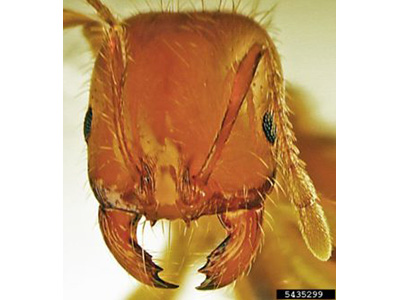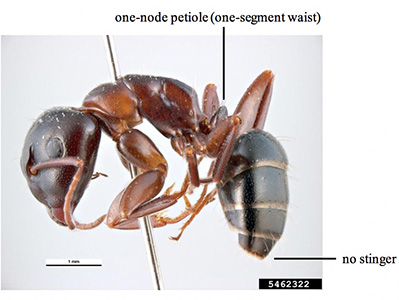What is a Fire Ant?
Even though there are several kinds of fire ants, the red imported fire ant (Solenopsis invicta) is the one most people encounter and refer to as a “fire ant”. Fire ants are polymorphic, meaning that within a colony they come in a range of sizes between 1/16 to 1/4 inches in length. They are red and black in color and are infamous for their burning sting. They are found throughout South Carolina, in addition to other southern states. Fire ant mounds are rarely larger than eighteen inches in diameter, and the ants will forage up to 100 yards away from the mound.1 A single queen can support a colony of up to 400,000 ants.1 When disturbed, fire ants emerge aggressively, crawl up vertical surfaces, and sting all at once.
Fire ant stings are painful, burn, and leave a white pustule on the skin. Stings can be incredibly painful to children and may detract from positive experiences with school gardening. Furthermore, approximately 1% of the population is hypersensitive to ant venom and can have a potentially lethal allergic reaction, such as anaphylactic shock.1 Very young children are most likely to react severely to fire ant stings, especially if they are stung multiple times in a single incident.

Figure 1. Fire ants have a two-node petiole, a ten-segmented antenna with a two-segmented club, and a stinger. Image credit: Eli Sarnat, PIAkey: Invasive Ants of the Pacific Islands, USDA APHIS PPQ, Bugwood.org.
A 2009 study identified 120 species of ants in South Carolina,2 but several visual characteristics are specific to fire ants. The images below show the differences in appearance between fire ants and another common group of ants, the carpenter ants. Fire ants have a two-node petiole (or a two-segmented waist), a ten-segmented antenna with a two-segmented club, a stinger (figure 1), and a mandible for pinching with four teeth (figure 2). Carpenter ants have a one-node petiole (or a one-segment waist) and no stinger (figure 3). Another way fire ants are differentiated from some other ants is by the appearance of their mounds. Fire ants do not have a central exit hole on top of their mound but rather use tunnels to enter and exit the mounds. If you see an ant mound with a central exit hole being used by ants, this is not a fire ant mound. Only fire ants exhibit all four physical traits mentioned above, as well as polymorphic colonies and distinctive mounds.

Figure 4. Morphological differences between winged ants and winged termites. Image credit: USDA Forest Service, Bugwood.org.
Some types of ants and termites can have individuals that have wings and can fly. Sometimes people confuse winged ants with termites. Winged fire ants can be differentiated from winged termites based on a pinched waist (a termite’s waist is not pinched), antennae placement on the head, and wing length (figure 4). Fire ants have elbowed antennae located on the side of the head and the two sets of wings are different lengths. Termites have straight, beaded antennae located on the front of the head and two sets of equal length wings.
The South Carolina Department of Health and Environmental Control (SCDHEC) has additional information about fire ant biology and stings on their website.
Help, I Have Fire Ants in My School Garden. What Should I Do?
Discovering fire ants in a school or community vegetable garden can be distressing for everyone involved. If you find fire ants in your school vegetable garden, quickly remove all children from the vicinity. Do not touch, step on, or kick the ants or mounds, or attempt to cover them with soil or any other material; these actions will startle the ants and cause them to become agitated and attack. After children are safely removed from the garden, contact the pest management professional for your school or community garden. Schools and community gardens on a publicly owned property must have a licensed pest management professional assigned by the school district, county, or municipality. This may be an employee of the organization or a commercial pest control operator under contract to apply pesticides. This individual or company is the only legal entity authorized to apply pesticides. Garden leaders must engage with their pest management professional to develop a plan to manage fire ants in their garden. Ideally, the pest management professional will schedule regular preventative insecticide treatments in the surrounding landscape rather than apply pesticides directly to the garden. An explanation of the South Carolina Pesticide Control Act and its implications for public spaces and government employees is available on the South Carolina Legislature website.
Are Educators or Non-Licensed Employees Allowed to Apply Pesticides to Control Fire Ants?
According to the South Carolina Pesticide Control Act, unlicensed employees cannot apply any pesticides on school property. Employees of a federal or state government agency are required to have a non-commercial applicators license in the state of South Carolina before they can apply any type of pesticides such as herbicides, insecticides, or rodenticides. Your school’s designated pest management professional will have the proper licensing and training to apply pesticides safely and legally. Additional information about pesticide licensing in South Carolina is available on the South Carolina’s Department of Pesticide Regulation (DPR) website.
If My Supervisor Has a Pesticide License, Do I Need One Too?
Only one person on staff (the supervisor) at a school needs to hold a non-commercial pesticide applicator license. Other employees may work under the license of this individual as long as they are working in South Carolina and within a 100-mile radius of this individual. There is no limit to how many people are allowed to work under the license of that one individual. However, it is highly encouraged that more than one individual be licensed at each school in case application treatments are needed and personal or work-related issues have caused the only license holder to travel more than 100 miles from the school.
The supervisor who holds the pesticide license and has others working under their license must provide proper training to their employees. The Department of Pesticide Regulation will hold the licensed individual liable for all errors that occur when others are working under their license. Monthly training is recommended for employees covering the topics of personal protective equipment (PPE), proper storage of pesticides, accurate reading of labels, and application safety.
Can I Apply Pesticides in the School Buildings?
There are different certification categories for licensing, and it is important to understand what is and is not permitted for the category of license held or worked under. For example, if the license is the Category 3 Ornamental and Turf Pest Control, the licensed individual and employees can treat fire ants on school grounds outdoors, but the license does not allow for treatments inside the school buildings. In order to apply pesticides inside school buildings, a Category 7A Structural License is required. The DPR takes 7A Structural License violations very seriously. Make sure you are working under the proper license. Information about the different licensing certification categories is available on the Department of Pesticide Regulation website.
If I’m Just Using Store-Bought Insect Spray, Am I Allowed to Apply Those on School Property without a License?
No. If you work for a school district or are on school-owned property, you must have a non-commercial pesticide license to apply any type of pesticide even for store-bought wasp, hornet, or ant sprays (such as Raid®) that you could apply without a license at your own home. On school property, the licensed individual and their employees are in close proximity to children on government-owned property and without a non-commercial pesticide license, lack the proper liability coverage and insurance necessary to apply a pesticide.
How Do I Prevent Fire Ants from Entering the School or Community Vegetable Garden?
The best way to manage fire ants in the garden is through preventative pest control measures on the garden grounds. You should contact the licensed pest management professional assigned to your school, county, or school district and ask them to treat for fire ants specifically. This will include scheduling routine, preventative insecticide treatments in the surrounding landscape.
Is There a Non-Pesticide Approach to Fire Ant Management?
No. There are no non-pesticide approaches to fire ant management that will control fire ants on school grounds. There are organic products that will work, but organic products are still considered an insecticide and require the proper licensing as outlined above. Fire ants should be managed through Integrated Pest Management (IPM) which uses information about insect lifecycles and interactions with the environment, in addition to available pest control methods, to manage pests. By implementing this approach, chemical methods such as insecticides will only be used when necessary and according to the label. This is the safest means of fire ant management for school and community garden grounds. More information on IPM is available on the Department of Pesticide Regulation website.
Are Home Remedies for Fire Ant Management Okay to Use?
No. In fact, some methods that are said to be home remedies can be dangerous. Using boiling water or gasoline to fight off fire ants will not kill the entire colony nor remove ants from the area; instead, the ants will become agitated and attack. Furthermore, you will also be at risk of burning yourself or others. Other methods such as dispersing grits or spreading diatomaceous earth around the mound are also ineffective. Grits will not cause a fire ant’s stomachs to explode, as worker fire ants cannot physically ingest solid food, but instead carry the food back to immature fire ants (larvae) in the mound to digest the food into a liquid for the rest of the colony to feed on. Diatomaceous earth applied on or around the mound will not reduce the fire ant population to an acceptable level, nor will it kill the queen, which would eliminate the colony. Home remedies to control fire ants should not be used on school or community garden grounds or around children under any circumstance. They are a safety risk and will not remove the ants. Instead contact the licensed pest control management professional for your school district, county, or municipality.
If you have further questions about pesticide licensing or application, or have encountered fire ants in your school or community garden and need assistance, please contact the agent at your county Extension office. You can also find more information on School Gardening for South Carolina Educators and our Fire Ant Management Workshops by following the Clemson Extension School and Community Gardening Facebook page.
References Cited
- Taber SW. Fire ants. College Station (TX): Texas A&M University Press; 2000.
- Davis T. The ants of South Carolina [dissertation]. [Clemson (SC)]: Clemson University; 2009.
https://tigerprints.clemson.edu/all_dissertations/331. - Oliver J, Vail KM. Managing fire ants in and around Tennessee’s schools. Knoxville (TN): University of Tennessee Press; 2019. https://extension.tennessee.edu/publications/Documents/PB1788.pdf.



